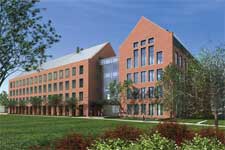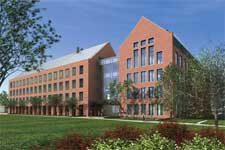 Building to support education, economic development, cutting edge research
Building to support education, economic development, cutting edge research
KINGSTON, R.I. – January 26, 2009 – The University of Rhode Island officially opened the doors today to the Center for Biotechnology and Life Sciences, the largest classroom and research building project in its history, with a grand celebration attended by numerous public officials, industry executives, and hundreds of URI faculty, staff and students.
The 140,000 square-foot facility houses modern teaching laboratories, cutting edge research laboratories, high-tech facilities for DNA sequencing and analysis, faculty offices, a 100-seat classroom, and a two-story, 300-seat auditorium, all to meet the needs of URI’s growing environmental biotechnology, life and health sciences programs.
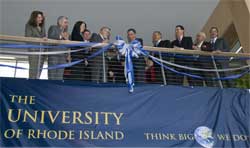 “Today we are opening a new chapter in URI’s ongoing success story as a leading research institution,” said Governor Donald L. Carcieri. “This $54 million, state-of-the-art facility will not only advance scientific research in a host of important areas, but it will also serve as a hub for training, research and job creation in the life sciences. Without question, this high-tech Center will contribute to our ongoing efforts to build an innovation economy. Whether it was providing funding for the planning and design of this academic facility in my budget five years ago or whether it was supporting the bond for the Center for Biotechnology and Life Sciences on the 2004 ballot, I have long been a proponent of this project. “
“Today we are opening a new chapter in URI’s ongoing success story as a leading research institution,” said Governor Donald L. Carcieri. “This $54 million, state-of-the-art facility will not only advance scientific research in a host of important areas, but it will also serve as a hub for training, research and job creation in the life sciences. Without question, this high-tech Center will contribute to our ongoing efforts to build an innovation economy. Whether it was providing funding for the planning and design of this academic facility in my budget five years ago or whether it was supporting the bond for the Center for Biotechnology and Life Sciences on the 2004 ballot, I have long been a proponent of this project. “
“This building will serve our students, our faculty, and the growing biotechnology sector here at the University of Rhode Island,” said URI President Robert L. Carothers. “It has been designed to create a learning environment that will allow students to become leaders in these emerging disciplines, while also creating a research environment in which our faculty can make discoveries and transmit new knowledge to the scientific community and to entrepreneurs.”
The Center features a dramatic four-story atrium that connects the research wing with the teaching wing, a rooftop patio, an open stairway that suggests the DNA double-helix, and interior spaces designed to encourage interaction among faculty and students. It also includes numerous design elements that will qualify it for LEED (Leadership in Energy and Environmental Design) Silver certification, just the second new construction project in the state to achieve the designation. The first was URI’s Hope Commons dining hall in 2008.
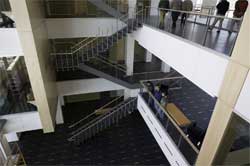 “This stunning building and the faculty and students it houses will be an important engine of economic development in the state’s biotechnology sector for many years to come,” said Jeff Seemann, URI dean of the College of the Environment and Life Sciences. “Its opening is a critically important step forward in Rhode Island’s economic recovery. The research and education that occurs in this building will fuel economic growth and workforce development in biotechnology, health and life sciences, and it will play a key role in driving the state’s new innovation-based economy.”
“This stunning building and the faculty and students it houses will be an important engine of economic development in the state’s biotechnology sector for many years to come,” said Jeff Seemann, URI dean of the College of the Environment and Life Sciences. “Its opening is a critically important step forward in Rhode Island’s economic recovery. The research and education that occurs in this building will fuel economic growth and workforce development in biotechnology, health and life sciences, and it will play a key role in driving the state’s new innovation-based economy.”
The Center for Biotechnology and Life Sciences is the anchor of the new North District of the Kingston Campus, which will also be the future home of new buildings for the University’s pharmacy, nursing and chemistry programs. A 113-acre technology park will be located on the opposite side of Flagg Road.
“The development of the North District will make URI a national leader in the life and health sciences and even more central to the economic development of Rhode Island,” said Robert Weygand, URI vice president for administration and finance. “It will increase opportunities for collaboration among faculty and help to create and maintain new relationships with corporate partners and other research and development institutions around the region.”
The architect for the Center was Payette Associates of Boston, and Providence-based Gilbane Building Co. served as the construction manager. The building was funded with a $50 million state bond approved by voters in 2004 and additional corporate, private and federal funds, including $1 million donated by Amgen. Total project costs were $54 million.
Notable sustainable design features include a ‘green’ roof that is partially covered in vegetation that will serve to filter pollutants and reduce heating and cooling needs; a rain garden and storm water treatment feature with a sophisticated drainage and detention system; daylight harvesting technologies to brighten rooms and warm the floors; an energy efficient heating and cooling system; and environmentally friendly framing and interior finish wood.
Another highlight is the aquarium lab, where fish and other marine life used in marine sciences research can be observed behind imposing glass windows. A student affairs office on the first level serves as a resource for students seeking advising, counseling, internships and other services. The fourth floor, which will contain administrative offices and additional laboratory space, will be fit-out at a later date as funds become available.
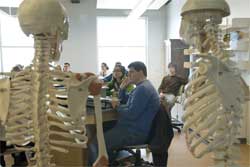 In addition to five classrooms and 14 teaching laboratories, the Center houses about 30 faculty members and their research groups. These scientists are working in such diverse fields as vaccine development, disease prevention, marine genomics, developmental and sensory biology, animal health and biofuels.
In addition to five classrooms and 14 teaching laboratories, the Center houses about 30 faculty members and their research groups. These scientists are working in such diverse fields as vaccine development, disease prevention, marine genomics, developmental and sensory biology, animal health and biofuels.
“Bringing biologists together in one building will facilitate great interactions among our faculty and among our students in a way that has not been possible before,” said Jacqueline Webb, professor of biological sciences. “The new teaching labs and auditoriums will significantly enhance our instructional capabilities in both classroom and laboratory settings. I know for a fact that the students are really looking forward to being able to take advantage of what this new building has to offer.”
Added U.S. Senator Jack Reed, who helped to secure $2.8 million in federal funding for the project: “This building brings together under one roof key elements of what URI does best. From pioneering research on Lyme disease, to developing the next generation of clean biofuels, to researching the health of Narragansett Bay, the University of Rhode Island is enhancing its position as a leader in higher learning and innovative research.”
Center for Biotechnology and Life Sciences
Fun Facts
The 140,000 square-foot building contains:
• 777 tons of steel
• 259,025 bricks
• 4,332 cubic yards of concrete
• 144 plumbing fixtures
• 133,335 pounds of sheet metal
• 1,787 light fixtures
• 83 miles of electrical wiring
In addition:
• energy efficiency measures installed in the building will save
about $135,000 per year in utility costs
• 100 percent of the wood used in construction was certified by
the Forest Stewardship Council to have come from
forests managed in a sustainable way
• 79 percent of construction waste was recycled
• 31 percent of the materials used in the building had been
previously recycled
Faculty research
The Center for Biotechnology and Life Sciences will house about 30 faculty members and their research groups. Among them are:
• Marian Goldsmith, professor and chair of the Department of Biological Sciences, who is applying the genetics and genomics of the domestic silkworm moth to understand how caterpillars may develop resistance to insecticides that have been engineered into crops. By searching for forms of resistance in silkworms, she hopes to gain a better understanding of resistance in agricultural pest species.
• Gonquin Sun, professor of biochemistry, investigates the biochemical mechanisms of protein tyrosine kinases, a family of enzymes that control normal cell communication and development and are often highly activated in cancer cells. He aims to elucidate how these enzymes are regulated, how they work in normal and cancer cells, and develop approaches to disrupt their function.
• Jacqueline Webb, professor of biological sciences, studies the evolution and development of sensory systems in fish. Her specialty is the study of the sensory system that allows fishes to detect water flows and vibrations that arise from predatory, prey and environmental obstacles, thus aiding in various aspects of critical behavior.
• Thomas Mather, professor of entomology and director of the Center for Vector-Borne Disease, is a leading expert on the diseases transmitted by ticks. He is designing targeted tick control strategies, investigating transmission risk, working to develop an effective vaccine against Lyme disease, and sharing his expertise with colleagues in Pakistan to address that nation’s growing tick problem.
• Marta Gomez-Chiarri, professor of fisheries, uses molecular tools in the prevention and management of infectious diseases in shellfish and finfish, including the development of vaccines and novel diagnostic methods. In her Aquatic Pathology Laboratory, she provides diagnostic and technical support to local aquaculturists, fisheries managers and restoration projects in Rhode Island.
• Albert Kausch, professor of cell and molecular biology, is working to genetically improve switchgrass with traits that will enhance bioenergy production and protect the environment. One major research goal is to produce hybrid varieties with increased biomass production that are also totally sterile for gene confinement, sound ecological stewardship and regulatory purposes.
 Read Providence Journal article (Sunday, Jan. 25, 2009) and view video.
Read Providence Journal article (Sunday, Jan. 25, 2009) and view video.

